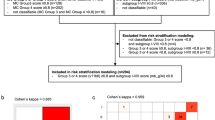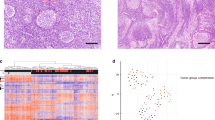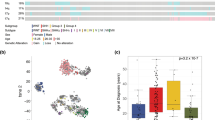Abstract
Medulloblastoma with extensive nodularity (MBEN) is a rare histological variant of medulloblastoma (MB). These tumors are usually occurring in the first 3 years of life and are associated with good prognosis. Molecular analyses of MBEN, mostly limited to single cases or small series, have shown that they always classify as sonic hedgehog (SHH)-driven MB. Here, we have analyzed 25 MBEN through genome-wide DNA methylation, copy-number profiling and targeted next-generation sequencing. Results of these analyses were compared with molecular profiles of other SHH MB histological variants. As expected, the vast majority of MBEN (23/25) disclosed SHH-associated epigenetic signatures and mutational landscapes but, surprisingly, two MBEN were classified as Group 3/4 MB. Most MBEN classified as SHH MB displayed SHH-related and mutually exclusive mutations in either SUFU, or PTCH1, or SMO at similar frequencies. However, only SUFU mutations were also identified in the germ-line. Most of SUFU-associated MBEN eventually recurred but patients were treated successfully with second-line high-dose chemotherapy. Altogether, our data show that risk stratification even for well-recognizable histologies such as MBEN cannot rely on histology alone but should include additional molecular analyses such as methylation profiling and DNA sequencing. For all patients with “MBEN” histology, we recommend sequencing SUFU and PTCH1 in the tumor as well as in the germ-line for further clinical stratification and choice of the optimal treatment strategy upfront.



Similar content being viewed by others
References
Abdel-Baki MS, Boué DR, Finlay JL, Kieran MW (2017) Desmoplastic nodular medulloblastoma in young children: a management dilemma. Neuro Oncol. https://doi.org/10.1093/neuonc/nox222 (Epub ahead of print)
Aristizabal P, Burns L, Rivera-Gomez R et al (2017) Medulloblastoma with extensive nodularity: tailored therapy in a low-resource setting. J Pediatr Hematol Oncol 39:299–301. https://doi.org/10.1097/MPH.0000000000000798
Brugières L, Remenieras A, Pierron G et al (2012) High frequency of germline SUFU mutations in children with desmoplastic/nodular medulloblastoma younger than 3 years of age. J Clin Oncol 30:2087–2093. https://doi.org/10.1200/JCO.2011.38.7258
Cavalli FMG, Remke M, Rampasek L et al (2017) Intertumoral heterogeneity within medulloblastoma subgroups. Cancer Cell 31:737–754. https://doi.org/10.1016/j.ccell.2017.05.005
Chelliah D, Sarfo-Poku CM, Stea BD, Gardetto J, Zumwalt J (2010) Medulloblastoma with extensive nodularity undergoing post-therapeutic maturation to a gangliocytoma: a case report and literature review. Pediatr Neurosurg 46:381–384
Garrè ML, Cama A, Bagnasco F et al (2009) Medulloblastoma variants: age-dependent occurrence and relation to Gorlin syndrome—a new clinical perspective. Clin Cancer Res 15:2463–2471. https://doi.org/10.1158/1078-0432.CCR-08-2023
Giangaspero F, Perilongo G, Fondelli MP et al (1999) Medulloblastoma with extensive nodularity: a variant with favorable prognosis. J Neurosurg 91:971–977
Guerrini-Rousseau L, Dufour C et al (2017) Germline SUFU mutation carriers and medulloblastoma: clinical characteristics, cancer risk and prognosis. Neuro Oncol. https://doi.org/10.1093/neuonc/nox228 (Epub ahead of print)
Kool M, Jones DT, Jäger N et al (2014) Genome sequencing of SHH medulloblastoma predicts genotype-related response to smoothened inhibition. Cancer Cell 25:393–405. https://doi.org/10.1016/j.ccr.2014.02.004
Kool M, Korshunov A, Remke M et al (2012) Molecular subgroups of medulloblastoma: an international meta-analysis of transcriptome, genetic aberrations, and clinical data of WNT, SHH, Group 3, and Group 4 medulloblastomas. Acta Neuropathol 123:473–484. https://doi.org/10.1007/s00401-012-0958-8
Korshunov A, Chavez L, Northcott PA et al (2017) DNA-methylation profiling discloses significant advantages over NanoString method for molecular classification of medulloblastoma. Acta Neuropathol 134(6):965–967. https://doi.org/10.1007/s00401-017-1776-9
Lafay-Cousin L, Smith A, Chi SN et al (2016) Clinical, pathological, and molecular characterization of infant medulloblastomas treated with sequential high-dose chemotherapy. Pediatr Blood Cancer 63:1527–1534. https://doi.org/10.1002/pbc.26042
Northcott PA, Buchhalter I, Morrissy AS et al (2017) The whole-genome landscape of medulloblastoma subtypes. Nature 547:311–317. https://doi.org/10.1038/nature22973
Pietsch T, Schmidt R, Remke M et al (2014) Prognostic significance of clinical, histopathological, and molecular characteristics of medulloblastomas in the prospective HIT2000 multicenter clinical trial cohort. Acta Neuropathol 128:137–149. https://doi.org/10.1007/s00401-014-1276-0
Rutkowski S, von Hoff K, Emser A et al (2010) Survival and prognostic factors of early childhood medulloblastoma: an international meta-analysis. J Clin Oncol 28:4961–4968. https://doi.org/10.1200/JCO.2010.30.2299
Sahm F, Schrimpf D, Jones DT et al (2016) Next-generation sequencing in routine brain tumor diagnostics enables an integrated diagnosis and identifies actionable targets. Acta Neuropathol 131:903–910
Suresh TN, Santosh V, Yasha TC et al (2004) Medulloblastoma with extensive nodularity: a variant occurring in the very young—clinicopathological and immunohistochemical study of four cases. Childs Nerv Syst 20:55–60
Taylor MD, Northcott PA, Korshunov A et al (2012) Molecular subgroups of medulloblastoma: the current consensus. Acta Neuropathol 123(4):465–472. https://doi.org/10.1007/s00401-011-0922-z
Author information
Authors and Affiliations
Corresponding author
Rights and permissions
About this article
Cite this article
Korshunov, A., Sahm, F., Stichel, D. et al. Molecular characterization of medulloblastomas with extensive nodularity (MBEN). Acta Neuropathol 136, 303–313 (2018). https://doi.org/10.1007/s00401-018-1840-0
Received:
Revised:
Accepted:
Published:
Issue Date:
DOI: https://doi.org/10.1007/s00401-018-1840-0




